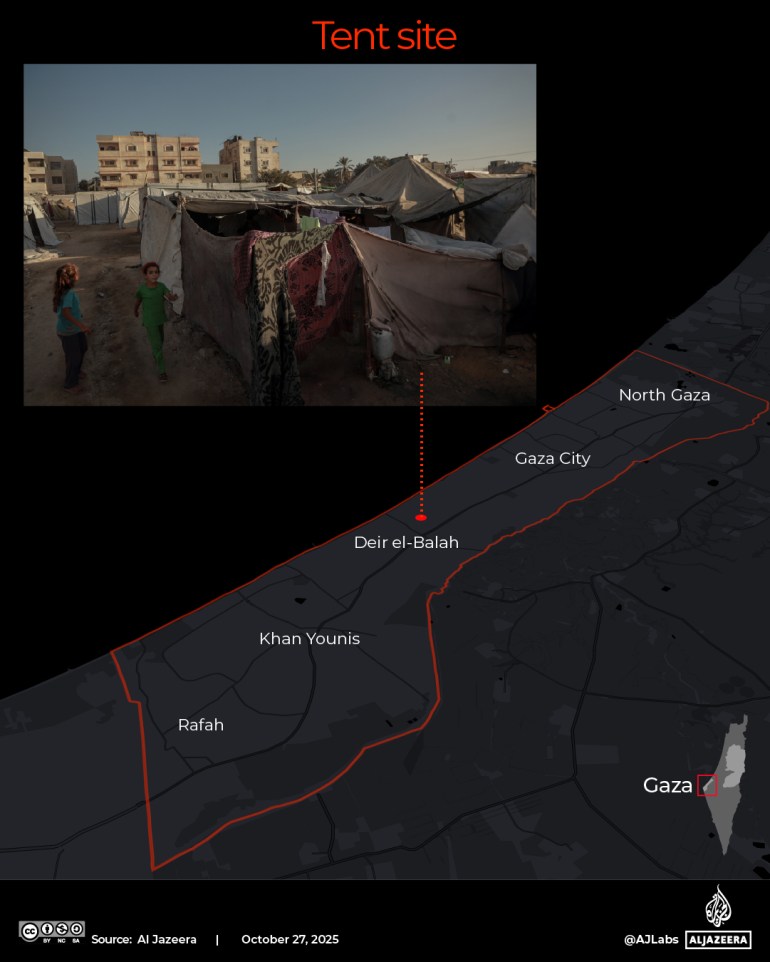Millions of Palestinians remain crammed into overcrowded tents, packed schools and other buildings, or sleeping on the streets of Gaza, as Israel continues its genocidal war on the enclave despite a fragile ceasefire.
Overcrowding, poor sanitation, a lack of food and a shortage of medicine have turned Gaza’s makeshift shelters into a breeding ground for infectious diseases.
“Even the minimum standards of human dignity and hygiene cannot be maintained under these conditions,” Samaher Saeed, Medical Aid for Palestine’s (MAP) protection manager in Gaza, tells Al Jazeera from southern Gaza.
“There’s no stability, no safety,” Saeed adds, capturing the daily reality faced by displaced Palestinians.
What is life like inside a Gaza tent?
To understand just what living conditions are like in a tent in Gaza, Al Jazeera visited a camp in Deir el-Balah, the governorate with the highest number of active shelters.

The living space is divided into outdoor and indoor areas. The outdoor section serves multiple daily needs, including cooking meals over an open fire, washing dishes, hanging clothes and using the outdoor toilet, while the indoor area is primarily for sleeping and shelter from the sun or rain.
The tent’s shaded area measures 20 sqm (215sq ft) and is shared by an average of 10 people, giving each just 2sqm (22sq ft) of personal space, well below the UNHCR’s recommended minimum of 3.5sqm per person and 2 metres (6.5ft) height for proper ventilation.

The tent itself is built from old blankets and fabric scraps, with sheets of nylon held up with ropes and supported by metal and wooden poles. These materials offer minimal protection from rain, do little to ensure privacy, and fail to regulate temperatures during cold winters and hot summers.
“The tents that were set up early in the war have completely deteriorated after two years of use; they no longer protect people from shrapnel, the summer heat or the winter cold,” says Saeed.
Earlier reporting by Al Jazeera in Gaza describes a mother speaking of “a summer that has ravaged children’s bodies” and being “eaten by flies and insects” where the “tent environment is very miserable”.

In the corners of the tent, personal belongings are stored in sacks and cardboard boxes, while clothes are hung up to maximise space, allowing them to be quickly packed in the face of Israel’s constant forced expulsion orders and incessant bombings.

Kitchen space
Kitchen utensils, pots and pans are tucked away in another corner of the outdoor living space, while plastic containers store precious drinking water.

Just outside, an open fire is used for cooking, but it sits next to piles of rubbish, including cardboard and other materials to be used as fuel, releasing harmful smoke into the air and creating health risks.

Hundreds of thousands of tonnes of rubbish have built up near camps.
Israel has restricted access to Gaza’s two main landfills, at Juhor ad-Dik in the north and al-Fukhari (also known as Sofa) in the south, where this rubbish would normally be taken.
As of February 2025, the continued denial of access to the Sofa landfill, located in the no-go zone, is preventing the transfer of solid waste from the 30 temporary dump sites and numerous persistent ad hoc sites.
“We often find ourselves in situations where we know that people are living in dangerous or undignified environments near sewage, waste dumps or unsafe shelters, but we simply have no alternative to offer them,” Saeed says.
Sleeping area
Sleeping arrangements are rough; the best people can hope for is to find a thin foam mattress to sleep on, but there isn’t one for each family member, and many end up sleeping on the ground. Blankets and pillows are stowed away during the day.

Toilet facilities
With few functioning toilets, people are forced to dig latrines or use buckets. According to MAP, on average, up to 600 people are forced to share a single latrine, 30 times more than the minimum standards.
Sewage and human waste flow into streets and near shelters as a result.

Lack of sanitation and hygiene
Access to basic sanitation and hygiene remains severely limited in Gaza, particularly for women.
Wafaa Nasrallah, a displaced mother of two, cannot afford to buy sanitary pads and has tried using rags and even nappies.
She is one of many women who cannot access hygiene items, and some have resorted to taking medication to stop their menstrual cycles entirely.
Menstruating women and girls also do not have access to enough water to wash or privacy in bathroom facilities to enable them to do so, even if they find the water.
“Girls are sleeping on bare ground during their periods due to the lack of clean bedding or private space,” says Saeed.
Israel has rendered more than 85 percent of Gaza’s water and sanitation infrastructure inoperable, from wells to treatment facilities.

Disease spreading
Preventable diseases are spreading in the camps due to overcrowding, the lack of clean facilities and a lack of medication.
According to a Journal of Medicine, Surgery, and Public Health paper published in April, Gaza currently faces an enormous infectious disease caseload, with 700,000 officially reported cases.
Contaminated water sources will “propagate waterborne illnesses such as cholera and dysentery, exacerbating the public health crisis”, where poverty, overcrowding, inadequate hygiene, contaminated food and a lack of safe drinking water all serve as significant risk factors for cholera.

